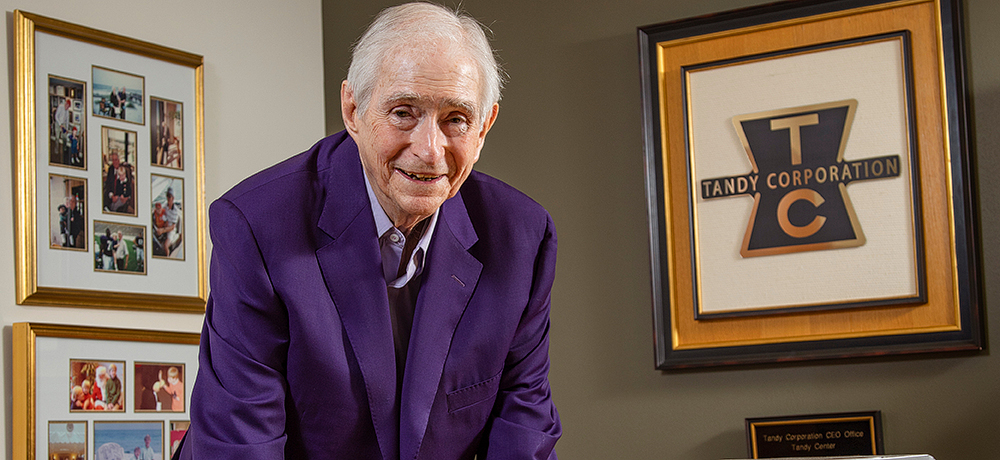Fifty years ago, John V. Roach ’61 MBA ’65 saw huge potential in the tiny microprocessor chip. He and his Fort Worth-based RadioShack helped usher in a previously unimaginable world driven by technology.
January 13, 2022
By Lisa Martin, TCU Magazine
If the modern world hinged on a before-and-after moment, the introduction of the world’s first commercial microprocessor in November 1971 would vie for the distinction. Without the Intel 4004 chip there would be no ATMs, no iPhones and no Zoom meetings.
A quarter-century ago, Byte magazine proclaimed the microprocessor “the life-support system of the modern world.” Subsequent historians, writers and social scientists have compared the microprocessor to the invention of the wheel and the written word.
Everything from tools to toys, appliances to automobiles incorporate microprocessors to speed up or otherwise improve function. These digital integrated circuits, which are about the size of a little fingernail, take in data, process that data according to the instructions programmed into their memories and provide output.
For a Cabbage Patch Kid doll in 1987, output consisted of a 400-word vocabulary, much to the delight of children who could make their baby girl or boy string together a sentence like “I love you” or “Milk, please.”
For home chefs, output meant restaurant-quality meals courtesy of a newfangled gadget called a food processor.
For physicians, dentists and other health care workers, output translated into everything from accessing a patient chart on a laptop to dashing off a digital prescription to a pharmacy.
Fifty years ago, few likely anticipated the outsized impact of this tiny piece of tech.
Making History
At the dawn of the 1970s, John Roach ’61 MBA ’65 did, in fact, have more than an inkling of the microprocessor’s potential impact. The tech visionary helped revolutionize personal computing, one of the earliest and most enduring beneficiaries of this technology.
“Back when the microprocessor was first invented, they were not well understood or well designed,” said Roach, who in 1981 became CEO of Tandy Corp., parent company of RadioShack. Founded in Fort Worth in 1919 as a leather goods company, Tandy acquired the Boston-based chain named Radio Shack in 1963 and rebranded as RadioShack Corp. in 2000.

Early on, RadioShack carried handheld calculators powered by microprocessors. At over $100, the calculators boasted far less computational power than something that would sell for under $10 today. Early models possessed mechanical buttons rather than anything approximating a touchscreen.
In 1975, the company dipped a toe into personal computing after Roach saw potential in the market and envisioned a time when people would use the devices at home. But early consumer interest lagged behind his expectations.
Undaunted, Roach put together a small engineering group within RadioShack’s manufacturing unit and charged it with discovering if it could build a commercially viable personal microcomputer.
During the research and development process, he and his team visited a microcomputer store in the heart of Silicon Valley.
“You’ve got to imagine what a microcomputer store was,” Roach said. “There were no computers there, just keyboards and other components you could use to build a microcomputer.”
RadioShack purchased black-and-white TVs with a gray cabinet from RCA and manufactured a coordinating gray plastic keyboard case. That initial computer, microprocessor included, was all in the keyboard.
CEO Charles Tandy ’40 LLD ’71 told Roach in January 1977 that if the computers didn’t sell, the company could use them in stores.
The first RadioShack microcomputer debuted in New York City on Aug. 3, 1977. The most popular version of the $600 TRS-80 included a monitor and a cassette player used for loading and saving data. The company was overwhelmed with orders.
RadioShack sold more than 100,000 microcomputers in 1978.
“It doesn’t seem like a huge number when you talk about the millions of computers sold today,” Roach said. “But it was by far the largest quantity sold that year in the industry.”
Read the full article from TCU Magazine here.

